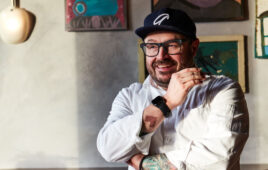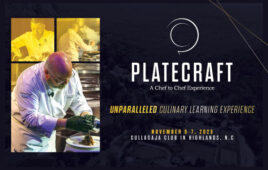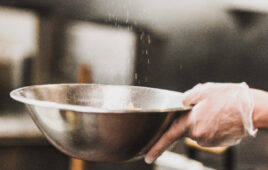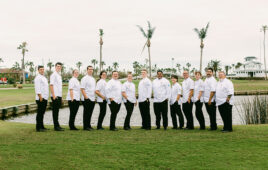 Executive Chef Max Knoepfel has drawn on his nearly 35 years of worldly experience to help Westchester CC carry on its strong F&B legacy without missing a beat.
Executive Chef Max Knoepfel has drawn on his nearly 35 years of worldly experience to help Westchester CC carry on its strong F&B legacy without missing a beat.
Westchester Country Club (WCC) is located in Rye, N.Y., just a few miles north of Manhattan. It was founded by John McEntee in 1922, when he commissioned Walter Travis to design two golf courses in conjunction with a luxury hotel called The Westchester Biltmore.
In its 90 years, WCC has had a long list of celebrities as members. Most notably, Johnny Carson, Jackie Gleason, Ed Sullivan, Gene Tunney and Howard Hughes have golfed, relaxed and dined at this suburban New York club. The Westchester Classic was a regular stop on the PGA Tour for more than 40 years. This past year, the club hosted one of the biggest stops on the Champions Tour, The Constellation Energy Senior Players Championship.
The kitchen at WCC has been loaded with talent for years as well. With a tremendous resume in hand, Chef Max Knoepfel took over last year for Ed Leonard, CMC, who moved on to become the Corporate Chef of Le Cordon Bleu Culinary Schools. Chef Max, as he is known, has drawn on his nearly 35 years of experience, which began with a Swiss Chef apprenticeship and has taken him to leading culinary venues around the world, to take a cutting-edge club F&B operation and make it even better. I would like to thank Max for taking the time from his busy schedule to share some of his tremendous culinary knowledge.
Q: Max, you’ve worked in just about every facet of our industry. When you went to WCC and sought to build on what your predecessor had accomplished, what was your philosophy for menu engineering?
A: The amazing menus that Chef Leonard and his team had created here were complex and trend-setting, and based in a great culinary pride. Through my communications with the dining membership, I brought back standard club favorites and new regional fare with our own culinary twists. The return to “familiar food done well,” with a local food terroire to exploit, was a huge success. Andre Soltner of Lutece would often say he did not make the fanciest food in New York city, but instead he may have made the best roast chicken possible. This was my philosophy. The membership votes with their feet, and our food venues are well-frequented. And with a great number of restaurants in our area, we are able to keep our members at the club.
It is a fine balance between elegant classic food and trendy food; the sales and member response drove menu changes. Some of the culinary team initially rebelled at serving, for example, a prime rib, until I actually walked them to the dining room to hear what members were saying about the food. In two of our restaurants, we introduced a summer farm-to-table menu, putting an emphasis on “Local Land, Local Food” and trying to work with local inspiration.
We also do very large catered events with very high standards that Paul Brock, our Director of Sales and Catering, and I expect from our team. Our goal is to create unique and special experiences for each and every event. Frequently, we host events for over 500 people and go out of our way to make them personable for each and every member and guest. Even at this size, we want to be perceived as trendy; we might even do molecular cuisine under the right circumstance.
Q: Many of us have challenges executing small-plate and tapas-style events—but you do large parties in this style flawlessly. How do you approach these efficiently in addressing issues such as service staff busing, rent-versus-buy china, action-station turnout, and overall labor costs?

WCC frequently hosts events for over 500 people—but that presents minimal challenges for Chef Knoepfel, who has served as many as 15,000 at a time over the course of his career.
A: I have had a career full of serving events, and the current trend is definitely towards small plates and tasting plates. It is fun and our kitchen brigade works very hard to make this happen. We actually challenge ourselves, sometimes almost as an inside bragging right, to come up with great dishes. Producing small plates does involve more cost but pays for itself in the end, and the return and feedback is greater than for traditional plated or passed events.
We have a fantastic Executive Steward, Jean St-Hilaire, who keeps up on the new and trendy dishes, so we can add to our collection of china. Lately we have introduced bamboo and “green bark” vessels, as well as some recycled paper, and mixed them into our variety of available options. I have been known to also look in hardware stores and to our suppliers for the unusual. If the budget is not there for special china, using what you have makes for creative efforts. For larger events we may rent if needed, but here again I ask our rental company to come up with trendy, multi-use vessels that can be used as complements to plated meal dishes.
For service, you need to educate and work with your front-of-house staff and stewarding department, to assure harmony and ownership of the vessels that are used.
Q: I assisted you and your staff at a few catered events at The Kennedy Center years ago, and can attest to the fact you are very organized. Do you have a template or philosophy for the components that must go into composing a hot entrée dish for a large plated meal banquet in a matter of minutes?
A: You need to be organized down to the last detail. Sometimes, I work the project backwards in my head, from a successful outcome through all the steps leading up to that moment. Organization, planning and knowledge of your team is key to a smooth and efficient result. Of course, having a tight grip on costs also goes along with each step—from payroll time of production, to stewarding and building off-site kitchen setups, to efficient breakdown and mise en place.
I always say to my staff, “Drip by drip, you make an ocean.” I have successfully done events with 11 steps on a main course for up to 15,000 people. For events of that size, you need to calculate in numbers of 250 or 500 and then multiply by kitchen stations—so 1,000 people is four kitchen stations and teams. The larger the number, the more every detail costs, and counts.
Q: What are the biggest challenges that you face operating an extremely busy satellite operation like the WCC Beach Club, along with three food venues and your Gun Club restaurant?
A: Staffing, of course, is a huge challenge. We hire 86 culinary and food operations staff to work in the kitchens over the summer, and go from essentially zero members/customers to possibly 1,200 members, literally overnight. The challenge is to have a plan and budget that are developed with human resources, use the contacts we have built upon, hire right—and then go high, wide and deep! And we encourage all staff to work until the last scheduled day.
Our Beach Club Chef, Gerald Ford, was hired last season and came from a very well-structured, classical hotel and club/restaurant background. He has a can-do attitude and a great passion for a job well done. Our Executive Sous Chef, Joe Albertelli, worked with Chef Gerald to set up great SOPs and training guidelines. We hired from local schools, local venues and some seasonal Florida clubs to staff the Beach Club’s culinary operation.
With the right combination of chefs and some culinary externs in management training from Cornell and the CIA, we had a professional but fun team, and it was one of the best years ever (minus the rainy days of the end of the summer) for our beach operations. We worked to accommodate and inspire our summer staff, as we do with every staff member. Some returned from previous years, and about 65% were new hires this past year. The exchange with clubs in locations like Florida, as well as Texas and Arizona, is something we will further develop.
I was very proud of how the membership embraced the new culinary Beach Club team. The result was a great summer with a great new menu, while continuing our educational mentoring of the staff with training of a very high caliber and a constant sense of culinary pride.
Q: Chef, we all know that aggressive recruitment of culinary talent goes a long way in raising the bar. Tell us about your European Exchange and ACF Apprentice programs, and how they work for you.
A: At WCC, we look at recruiting first from local schools, community colleges and the greater New York-area culinary schools, which includes the Culinary Institute of America, to ensure that we have a talented and diverse team. We also have a two-year apprenticeship that was started by my predecessor, Chef Leonard, and at the end of the year we will have another three culinarian graduates. In addition, we have fostered exchange programs in Europe, Latin America, Asia and South Africa.
The club lends itself to be a great host site for professional exposure to restaurants, catering, banquets, our seasonal Beach Club, and our pastry shop. WCC provides a well-rounded apprenticeship or extern site for inspiring chefs who are willing to work hard, with passion for culinary pride. It also proves to be a wonderful learning experience for any committed culinarian who wants to be exposed to a very high-end culinary operation. We are very blessed to have the extraordinary leadership of our Executive Director, Robert James, CCM; our General Manager, Michael Feil, CCM, and a tremendous commitment from our membership, which fully supports and encourages our passion for mentoring.
Q: Finally, Chef, tell us more about your Local Land, Local Food event—where did the inspiration come from?
A: Our team at WCC is very excited about hosting this first event with local farmers, the Westchester County Land Trust, the Slow Food Movement, our local ACF Chapter, the Connecticut Club Chef Association and the Westchester Club Chef Association.
My philosophy is that we all need to be good stewards to the land and know our terroire. Upon arriving at WCC last year, it was a big discovery to come into a region with such bounty—but also to find that much of it was hidden, in terms of a presence on our menus.
The local chefs and some vendors guided me on who to approach, and in April I had the pleasure to see some local farms in Bedford and Mt. Kisco, N.Y, about 35 miles from the club. We set to work over the summer to introduce farm-to-table and procure our vegetables and fruits locally.
I set up procedures for contact between the farmers and chefs. These involve sending updated growing lists and pictures by e-mail or web pages to our chefs, completing order placement through our purchaser, and then delivering, after harvest the next morning, fresh for mise en place for dinner.
Chefs have also become the educators of our customers. In our case, we spoke about our movement to farm-to-table to our members during service table visits. Hannah Matarazzo, our Gun Club Chef this past summer, also has encouraged the farms to make many new plantings. We are always looking to educate and inspire other chefs and farmers to get involved.
View Chef Knoepfel’s recipes:





